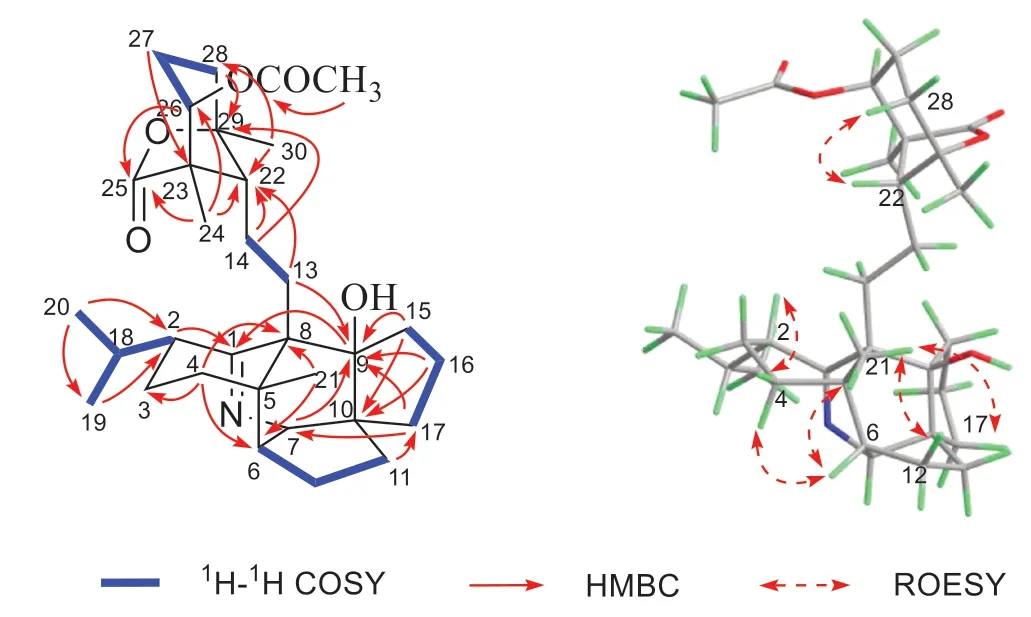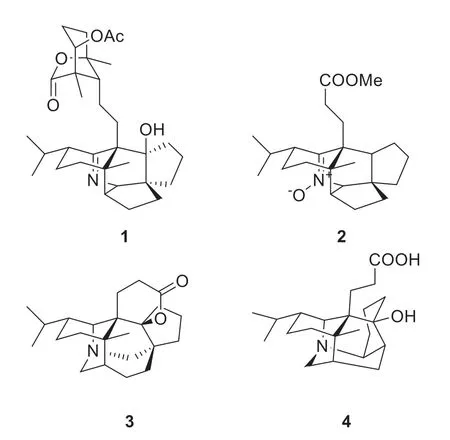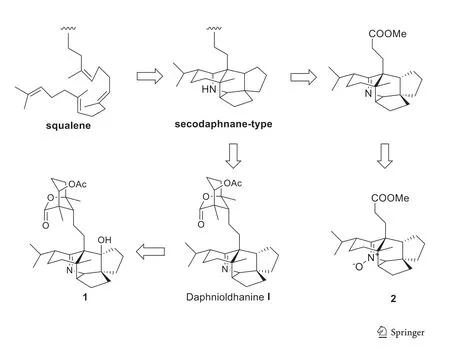New Secodaphnane-Type Alkaloids with Cytotoxic Activities from Daphniphyllum angustifolium Hutch
2021-08-10QingYunLuJiaHuiZhangYingYaoLiXueXuePuCuiShanZhangShuaiLiuJiaJiaWanYingTongDiXiaoJiangHao
Qing-Yun Lu ·Jia-Hui Zhang·Ying-Yao Li ·Xue-Xue Pu·Cui-Shan Zhang ·Shuai Liu·Jia-Jia Wan ·Ying-Tong Di·Xiao-Jiang Hao
1 State Key Laboratory of Phytochemistry and Plant Resources in West China,Kunming Institute of Botany,Chinese Academy of Sciences,Kunming 650201,People’s Republic of China
2 School of Life Sciences,Southwest University,Chongqing 400715,China
3 Yunnan University,Kunming,People’s Republic of China
4 Yunnan University of Traditional Chinese Medicine,Kunming,People’s Republic of China
5 University of Chinese Academy of Sciences,Beijing 100049,People’s Republic of China
Abstract One new Daphniphyllum alkaloid,daphnioldhanol A(1),together with three known ones,were isolated from the stem part of Daphniphyllum angustifolium Hutch.Their structures were elucidated by spectroscopic methods and comparing with the literature data.Compound 2 is a new natural product,but known by synthesis as a racemate.Compound 1 exhibited week cytotoxic activity against Hela cell line with IC50 of 31.9 μM.
Keywords Daphniphyllum angustifolium hutch·Secodaphnane-type·Daphnioldhanol A·Cytotoxic activity
1 Introduction
Alkaloids are a class of compounds with significant activities(with a variety of novel skeletons)that are widely found in nature[1-7].Daphniphyllumalkaloids are a structurally diversified group of complex polycyclic natural products isolated from theDaphniphyllumgenus[8].Since these unique,versatile and complex nitrogen heterocyclic compounds exhibit a wide range of biological activities and are extremely challenging,they have aroused great interest in total synthesis and biosynthetic studies[9-16].In recent years,quite a number of newDaphniphyllumalkaloids have been isolated and identified,and some of them possessed novel skeletons[17-20].In our continued search forDaphniphyllumalkaloids with interesting skeletons[21-24],one newDaphniphyllumalkaloid,daphnioldhanol A(1),together with three known ones,were isolated from the stems ofDaphniphyllum angustifoliumHutch(Fig.1).Herein,the isolation,structural elucidation,and bioactivities of these compounds are reported.
2 Results and Discussion
2.1 Structure Elucidation of the Compounds
Daphnioldhanol A(1)was obtained as white amorphous powder.Its molecular formula,C32H48NO5,was established by positive HRESIMS atm/z526.3534[M+H]+(calcd 526.3534),with 10 degrees of unsaturation.The IR absorptions implied the presence of hydroxyl(3441 cm−1),and an imine moiety(1631 cm−1).The13C NMR and DEPT data of 1 displayed 32 carbon signals(Table 1),due to three tetrasubstitutedsp2carbon atoms at lower field and 29sp3carbon atoms(5×C,6×CH,11×CH2,6×CH3)at higher field.According to the molecular formula and relative NMR data,one CH group(δC65.4,δH2.95)was ascribed to those bearing an N-atom,while one quaternary C-atom(δC84.4)were attributed to those bearing an O-atom.Additionally,threesp2quaternary carbons were attributable to one lactone carbonyl(δC180.2),one ester carbonyl(δC172.2),and one iminium group(δC168.4),while taking into account the three degrees ofunsaturation.The remaining seven degrees of unsaturation were accounted for the presence of the heptacyclic system of 1.

Table 1 1 H and 13 C NMR spectroscopic data for compound 1 a(δ in ppm and J in Hz)
The1H and13C NMR spectra of 1 were closely related to those of the known compound Daphnioldhanine I[25],with the exception of the loss of signal for a CH in the latter and the addition of signal for quaternary carbon with a hydroxyl(δC84.4),which were supported by the HMBC correlations of H-11/C-9,H-13/C-9,H-15/C-9,H-16a/C-9,H-17/C-9.
To determine the orientation of the hydroxyl at C-9,we compared the13C NMR data of both 1 and daphnioldhanine I,which revealed that 9-OH substituent significantly shields the C-21(5 ppm decrease)in the former.This indicated that the 9-OH in 1 should take aβ-orientation.Moreover,the remaining relative configuration of 1 was elucidated from ROESY correlations as shown in computer-generated 3D drawing,which was the same as that of the daphnioldhanine I(Fig.2).

Fig.2 1 H-1 H COSY,key HMBC and ROESY correlations of 1
The known compounds were identified as(−)-nitrone 17(2)[26],daphnilactone A(3)[27],dapholdhamine B(4)[28],respectively,by comparison of their spectroscopic data with those reported in the literature(Fig.1).Compound 2 was obtained as white amorphous powder.MS analysis of 2 revealed a[2 M+H]+peak atm/z747.By comparison of its1H and13C NMR data with those of(±)-nitrone 17 in the literature,high similarity between them indicated that 2 shared the same structure as the latter.However,the compound 2 is a new chiral natural product with OR at−31.75°,but known by synthesis is racemate.

Fig.1 The structures of compounds 1-4
A plausible biogenetic pathway for 1 and 2 was proposed as shown in Scheme 1.Biogenetically,both 1 and 2 should be the derivatives of secodaphnane-type alkaloid[13,29],which might be originated from sequalene,as proposed from Heathcock[26].Then,1 and 2 might be formed via diff erent pathway.

Scheme 1 Plausible Biosynthetic Pathway of 1
2.2 Cytotoxic Activity
Both compounds 1 and 2 have been tested for their cytotoxicity against Hela,MCF-7,A549,MGC-803 and COLO-205 human cancer cell lines in vitro.The results indicated that 1 exhibited weak cytotoxic activity against Hela cell line with IC50of 31.9 μM(Table 2).

Table 2 Cytotoxic activity of Compound 1 against Hela,MCF-7,A549,MGC-803 and COLO-205 human cancer cell lines in vitro
3 Experimental
3.1 General Experimental Procedures
Optical rotations were measured with a Jasco P-1020 polarimeter.UV spectra were obtained using a Shimadzu UV-2401A spectrophotometer.A Tenor 27 spectrophotometer was used for IR spectra as KBr pellets.1D and 2D NMR spectra were recorded on Bruker spectrometer with TMS as internal standard.HRESIMS was performed on a triple quadrupole mass spectrometer.Semi-preparative HPLC was performed on an Agilent 1100 liquid chromatograph with a Waters X-Bridge Prep Shield RP18(10×150 mm)column.Column chromatography(CC)was performed using silica gel(100-200 mesh and 300-400 mesh,Qingdao Marine Chemical,Inc.,Qingdao,P.R.China)and Sephadex LH-20(40-70 μm,Amersham Pharmacia Biotech AB,Uppsala,Sweden).
3.2 Plant Material
The stems ofDaphniphyllum Angustifoliumused in this study was collected from Jinfo mountain,Chongqing,P.R.China,in October 2013,and botanically authenticated by professor Deng Hong-ping.A voucher specimen(KIBHAO2014012)was deposited in State Key Laboratory of Phytochemistry and Plant Resources in West China,Kunming Institute of Botany,Chinese Academy of Sciences.
3.3 Extraction and Isolation
Air-dried stems ofDaphniphyllum Angustifolium(20 kg)were powdered and extracted with MeOH(24 h×3)at room temperature,and the solvent was evaporated in vacuo.The MeOH extract was then partitioned between EtOAc and TFA/H2O at pH 3.0.Water-soluble materials,after being adjusted at pH 10.0 with saturated Na2CO3,were partitioned with CHCl3.CHCl3-soluble materials(100.6 g)was subjected to silica gel column chromatography(CC)and eluted with gradient CHCl3/MeOH to yield five fractions F-1-F-5.F-4 was repeatedly submitted to silica gel CC and Sephadex LH-20,then purified by HPLC to aff ord compounds 1(1.2 mg)and 2(2.0 mg).Accordingly,3(18.0 mg)was obtained from F-1;4(2.5 mg)was obtained from F-5.
3.4 Daphnioldhanol A(1)
Daphnioldhanol A(1):White amorphous powder;C32H47NO5;Positive HR-EI-MS atm/z526.3534[M+H]+(calcd.for C32H48NO5,526.3527);MeOH);UV(MeOH)λmax(logε)265(3.43)nm,242(3.56)nm,215(3.93)nm;IR:νmax(KBr)cm-1:3440,2928,2869,1772,1743,1713,1631,1383,1226,1057,1028 cm-1.
3.5 Nitrone 17(2)
(−)-Nitrone 17(2):Colorless oil;C23H35NO3;ESI-MS(positive):m/z747[2 M+H]+;1H NMR(CDCl3,400 MHz)δH:3.72(3H,s),1.58(3H,s),1.02(1H,d,6.16),0.94(3H,s),0.85(3H,d,6.48);13C NMR(CDCl3,100 MHz)δC:157.2(C-1),48.8(C-2),27.0(C-3),39.0(C-4),51.7(C-5),52.5(C-6),84.1(C-7),50.9(C-8),52.5(C-9),52.9(C-10),33.4(C-11),22.7(C-12),26.2(C-13),31.6(C-14),25.7(C-15),37.0(C-16),38.9(C-17),31.5(C-18),21.0(C-19),20.6(C-20),23.3(C-21),174.1(C-22),51.9(C-23).
3.6 Cytotoxicity Assays
Cytotoxic activity of compound 1 against Hela,MCF-7,A549,MGC-803,and COLO-205 human cancer cell lines in vitro were measured using methylthiazoletetrazolium(MTT)assay[30].Doxorubicin was used as a positive control.
4 Concluding Remarks
In conclusion,one newDaphniphyllumalkaloid,daphnioldhanol A(1),together with three known ones,were isolated from the stem part ofD.angustifoliumHutch.Compound 1 exhibited week cytotoxic activity against Hela cell line.
Supplementary InformationThe online version contains supplementary material available at https://doi.org/10.1007/s13659-021-00309-w.
AcknowledgementsThis work was financially supported by the National Natural Science Foundation of China(No.31770392 to YTD),and the Science and Technology Program of Yunnan Province(2018ZF013 to YTD).The authors are grateful to the analytical group of the Laboratory of Phytochemistry,Kunming Institute of Botany,Chinese Academy of Sciences,for recorded spectra.
Declarations
Conflict of interestAuthors declare that there is no conflict of interest.
Open AccessThis article is licensed under a Creative Commons Attribution 4.0 International License,which permits use,sharing,adaptation,distribution and reproduction in any medium or format,as long as you give appropriate credit to the original author(s)and the source,provide a link to the Creative Commons licence,and indicate if changes were made.The images or other third party material in this article are included in the article’s Creative Commons licence,unless indicated otherwise in a credit line to the material.If material is not included in the article’s Creative Commons licence and your intended use is not permitted by statutory regulation or exceeds the permitted use,you will need to obtain permission directly from the copyright holder.To view a copy of this licence,visit http://creat iveco mmons.org/licen ses/by/4.0/.
杂志排行
Natural Products and Bioprospecting的其它文章
- Tangutidines A-C,Three Amphoteric Diterpene Alkaloids from Aconitum tanguticum
- Psathyrellins A-E,Antibacterial Guanacastane Diterpenoids from Mushroom Psathyrella candolleana
- Screening and Purification of Natural Products from Actinomycetes that Induce a“Rounded”Morphological Phenotype in Fission Yeast
- Diterpenoid Alkaloids from the Aerial Parts of Aconitum flavum Hand.-Mazz
- Naturally Occurring Terpenes:A Promising Class of Organic Molecules to Address Influenza Pandemics
- α-C(sp3)-H Arylation of Cyclic Carbonyl Compounds
